How to use the CLEAN function
What is the CLEAN function?
The CLEAN function deletes non-printable characters from a value in 7-bit ASCII code.
Table of Contents
1. Introduction
Why delete non-printable characters?
Sometimes data imported from other software may contain characters that don't print with your operating system.
What is a non printable character?
The first 32 non-printing characters in the 7-bit ASCII code from 0 (zero) to 31. There are more non-printing characters in the Unicode character set more specifically values 127, 129, 141, 143, 144, and 157.
What is 7-bit ASCII code?
ASCII stands for American Standard Code for Information Interchange. There are 256 characters in the ASCII code set, numbered from 0 to 255. The standard characters like as letters, digits, and symbols are the same on all computers and occupy the first 128 positions 0 to 127. The remaining characters depend on the selected language and regional settings 128 to 255.
Does the CLEAN function delete non-printing characters from the Unicode character set?
The CLEAN function does not delete the Unicode character set which has additional non-printing characters (values 127, 129, 141, 143, 144 and 157).
Formula in cell D3:
The picture above shows ANSI codes for each character so you easily can spot the characters that the CLEAN function can delete.
For example, ANSI character 29 is deleted by the CLEAN function above, 29 is among the first 32 non-printing characters in 7-bit ASCII code.
2. Syntax
CLEAN(text)
| text | Required. A value from which you want to remove non-printable characters |
3. Example
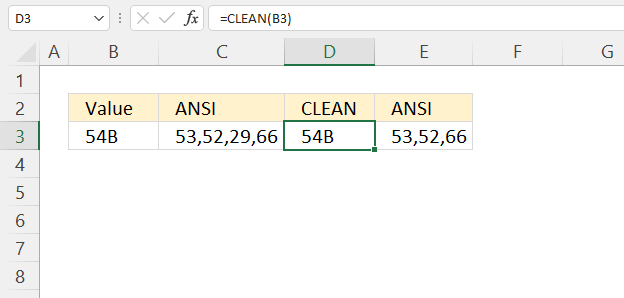
This example demonstrates the CLEAN function, the image above shows a formula in cell D3 that removes non-printable characters from cell B3.
Cell B3 contains these characters in ANSI code: 53, 52,29, and 66. Character 29 in ANSI is removed and only 53, 52, and 66 are now left in cell D3.
Formula in cell D3:
Non-printable characters are the first 32 in 7-bit ASCII code.
4. CLEAN function - array
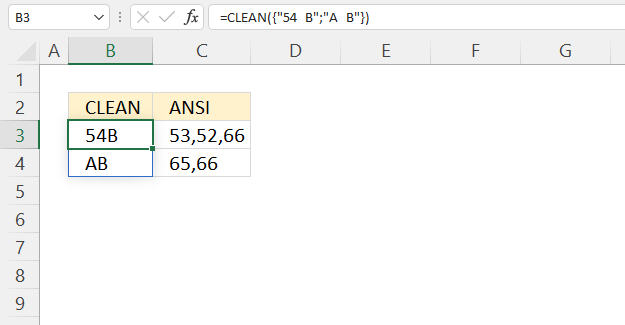
The image above demonstrates a formula that removes non-printable characters in an array. The argument contains two values in the array.
Formula in cell B3:
Both values contain non-printable characters which are removed in the output values. The corresponding cells in column C show the ANSI code for each character in the output value.
Explaining formula
CLEAN({"54 B";"A B"})
returns
{"54B";"AB"}
5. CLEAN function - string
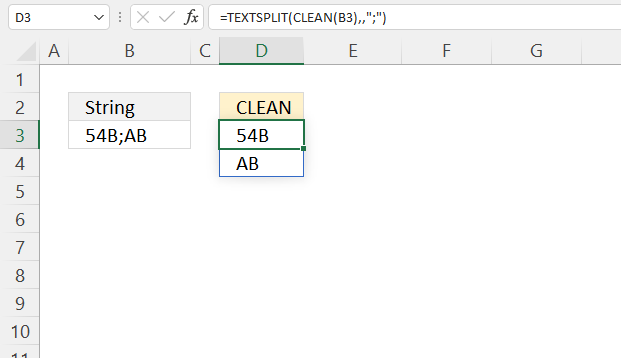
This formula cleans a cell value containing strings separated by a semicolon, the result is an array that is spilled to cells below which doesn't contain non-printable characters.
Excel 365 dynamic array formula in cell D3:
Explaining formula
Step 1 - Remove non-printable characters
CLEAN(B3)
becomes
CLEAN("54 B;A B")
and returns
"54B;AB"
Step 2 - Split values into an array
The TEXTSPLIT function splits a string into an array based on delimiting values.
Function syntax: TEXTSPLIT(Input_Text, col_delimiter, [row_delimiter], [Ignore_Empty])
TEXTSPLIT(CLEAN(B3),,";")
becomes
TEXTSPLIT("54B;AB")
and returns {"54B;AB"}.
6. Check if a cell contains non-printable characters
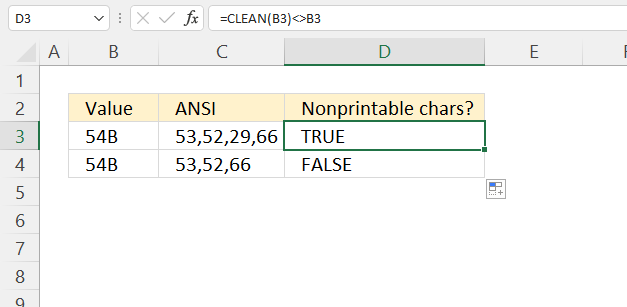
The following formula checks if a cell value contains non-printable characters. It returns TRUE if the cell value contains non-printable characters.
Formula in cell D3:
The value in cell B3 contains a non-printable character, the corresponding ANSI characters are displayed in cell C3. The formula in cell D4 returns TRUE meaning there is a t least one non-printable character in cell B3.
Explaining formula
Step 1 - Remove non-printable characters
CLEAN(B3) becomes CLEAN("54 B")
and returns "54B".
Step 2 - Get source value
B3 returns "54 B".
Step 3 - Check if not equal
The less than and larger than signs let you compare value to value, it returns TRUE if they are not a match.
CLEAN(B3)<>B3
becomes
"54B"<> "54 B"
and returns TRUE.
7. Check if a cell range contains non-printable characters
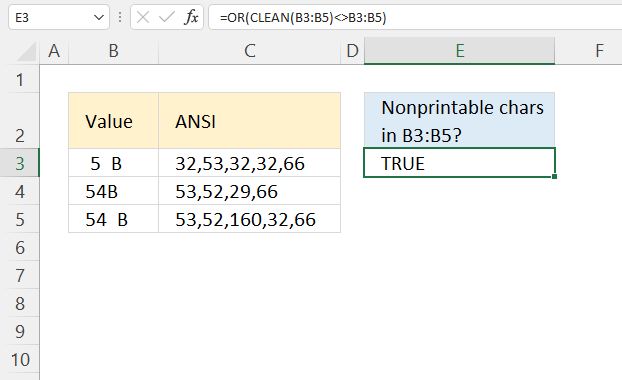
The following formula checks if values in a specific cell range contains non-printable characters. It returns TRUE if it contains at least one non-printable character.
Formula in cell D3:
This example checks if cell range B3:B5 contains non-printable characters. Cells C3:C5 shows the characters' corresponding ANSI code, the CLEAN function removes characters 0 (zero) to 31 in the ANSI character set coding.
Explaining formula
Step 1 - Remove non-printable characters
CLEAN(B3:B5)
becomes
CLEAN({" 5 B";"54 B";"54 B"})
and returns
{" 5 B";"54B";"54 B"}
Step 2 - Get values from cell range
B3:B5
returns
{" 5 B";"54 B";"54 B"}
Step 3 - Check if not equal
The less than and larger than signs let you compare value to value, it returns TRUE if they are not a match.
CLEAN(B3:B5)<>B3:B5
becomes
{" 5 B";"54B";"54 B"}<>{" 5 B";"54 B";"54 B"}
and returns
{FALSE; TRUE; FALSE}.
Step 4 - Apply OR logic
The OR function evaluates a logical expression in each argument and if at least one argument returns TRUE the OR function returns TRUE. If all arguments return FALSE the OR function also returns FALSE.
Function syntax: OR(logical1, [logical2])
OR(CLEAN(B3:B5)<>B3:B5)
becomes
OR({FALSE; TRUE; FALSE})
and returns TRUE.
8. Highlight cells containing non-printable characters
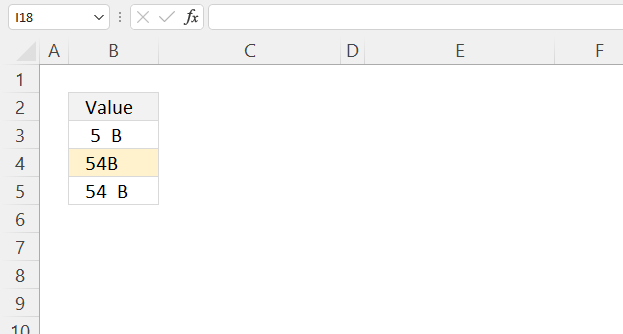
The image above shows a conditional formatting formula highlighting cells that contain non-printable characters.
Conditional Formatting Formula:
This formula is the same formula as in section 6.
Explaining formula
Step 1 - Remove non-printable characters
CLEAN(B3) becomes CLEAN("54 B")
and returns "54B".
Step 2 - Get source value
B3 returns "54 B".
Step 3 - Check if not equal
The less than and larger than signs let you compare value to value, it returns TRUE if they are not a match.
CLEAN(B3)<>B3
becomes
"54B"<> "54 B"
and returns FALSE. Cell B3 does not contain at least one non-printable character.
How to apply Conditional formatting
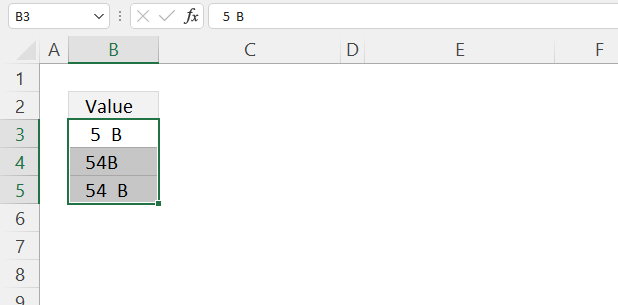
- Go to tab "Home" on the ribbon.
- Press with left mouse button on the "Conditional Formatting" button, a popup menu appears.
- Press with left mouse button on "New Rule...", and a dialog box shows up.
- Enter the formula described below the image above.
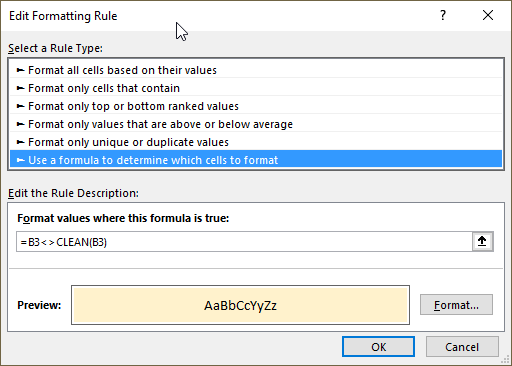
- Press with left mouse button on the "Format..." button, a new dialog box appears.
- Pick a "Fill" color.
- Press with left mouse button on OK button to dismiss the dialog box.
- You are now back to the first dialog box.
- Press with left mouse button on the "OK" button to dismiss this dialog box as well.
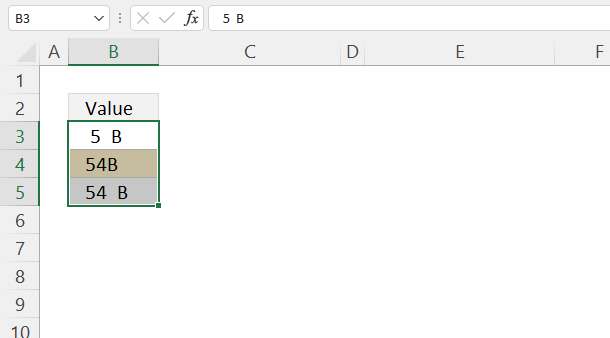
9. Function not working

The CLEAN function returns
- #NAME? error if you misspell the function name.
- propagates errors, meaning that if the input contains an error (e.g., #VALUE!, #REF!), the function will return the same error.
9.1 Troubleshooting the error value

When you encounter an error value in a cell a warning symbol appears, displayed in the image above. Press with mouse on it to see a pop-up menu that lets you get more information about the error.
- The first line describes the error if you press with left mouse button on it.
- The second line opens a pane that explains the error in greater detail.
- The third line takes you to the "Evaluate Formula" tool, a dialog box appears allowing you to examine the formula in greater detail.
- This line lets you ignore the error value meaning the warning icon disappears, however, the error is still in the cell.
- The fifth line lets you edit the formula in the Formula bar.
- The sixth line opens the Excel settings so you can adjust the Error Checking Options.
Here are a few of the most common Excel errors you may encounter.
#NULL error - This error occurs most often if you by mistake use a space character in a formula where it shouldn't be. Excel interprets a space character as an intersection operator. If the ranges don't intersect an #NULL error is returned. The #NULL! error occurs when a formula attempts to calculate the intersection of two ranges that do not actually intersect. This can happen when the wrong range operator is used in the formula, or when the intersection operator (represented by a space character) is used between two ranges that do not overlap. To fix this error double check that the ranges referenced in the formula that use the intersection operator actually have cells in common.
#SPILL error - The #SPILL! error occurs only in version Excel 365 and is caused by a dynamic array being to large, meaning there are cells below and/or to the right that are not empty. This prevents the dynamic array formula expanding into new empty cells.
#DIV/0 error - This error happens if you try to divide a number by 0 (zero) or a value that equates to zero which is not possible mathematically.
#VALUE error - The #VALUE error occurs when a formula has a value that is of the wrong data type. Such as text where a number is expected or when dates are evaluated as text.
#REF error - The #REF error happens when a cell reference is invalid. This can happen if a cell is deleted that is referenced by a formula.
#NAME error - The #NAME error happens if you misspelled a function or a named range.
#NUM error - The #NUM error shows up when you try to use invalid numeric values in formulas, like square root of a negative number.
#N/A error - The #N/A error happens when a value is not available for a formula or found in a given cell range, for example in the VLOOKUP or MATCH functions.
#GETTING_DATA error - The #GETTING_DATA error shows while external sources are loading, this can indicate a delay in fetching the data or that the external source is unavailable right now.
9.2 The formula returns an unexpected value

To understand why a formula returns an unexpected value we need to examine the calculations steps in detail. Luckily, Excel has a tool that is really handy in these situations. Here is how to troubleshoot a formula:
- Select the cell containing the formula you want to examine in detail.
- Go to tab “Formulas” on the ribbon.
- Press with left mouse button on "Evaluate Formula" button. A dialog box appears.
The formula appears in a white field inside the dialog box. Underlined expressions are calculations being processed in the next step. The italicized expression is the most recent result. The buttons at the bottom of the dialog box allows you to evaluate the formula in smaller calculations which you control. - Press with left mouse button on the "Evaluate" button located at the bottom of the dialog box to process the underlined expression.
- Repeat pressing the "Evaluate" button until you have seen all calculations step by step. This allows you to examine the formula in greater detail and hopefully find the culprit.
- Press "Close" button to dismiss the dialog box.

There is also another way to debug formulas using the function key F9. F9 is especially useful if you have a feeling that a specific part of the formula is the issue, this makes it faster than the "Evaluate Formula" tool since you don't need to go through all calculations to find the issue..
- Enter Edit mode: Double-press with left mouse button on the cell or press F2 to enter Edit mode for the formula.
- Select part of the formula: Highlight the specific part of the formula you want to evaluate. You can select and evaluate any part of the formula that could work as a standalone formula.
- Press F9: This will calculate and display the result of just that selected portion.
- Evaluate step-by-step: You can select and evaluate different parts of the formula to see intermediate results.
- Check for errors: This allows you to pinpoint which part of a complex formula may be causing an error.
The image above shows cell reference B3 converted to hard-coded value using the F9 key. The CLEAN function requires non-error values which is not the case in this example. We have found what is wrong with the formula.
Tips!
- View actual values: Selecting a cell reference and pressing F9 will show the actual values in those cells.
- Exit safely: Press Esc to exit Edit mode without changing the formula. Don't press Enter, as that would replace the formula part with the calculated value.
- Full recalculation: Pressing F9 outside of Edit mode will recalculate all formulas in the workbook.
Remember to be careful not to accidentally overwrite parts of your formula when using F9. Always exit with Esc rather than Enter to preserve the original formula. However, if you make a mistake overwriting the formula it is not the end of the world. You can “undo” the action by pressing keyboard shortcut keys CTRL + z or pressing the “Undo” button
9.3 Other errors
Floating-point arithmetic may give inaccurate results in Excel - Article
Floating-point errors are usually very small, often beyond the 15th decimal place, and in most cases don't affect calculations significantly.
Useful resources
Clean function - Microsoft support
Clean Function to Clean Entire Sheet
How to combine two Excel functions (TRIM and CLEAN) in one formula?
Functions in 'Text' category
The CLEAN function function is one of 29 functions in the 'Text' category.
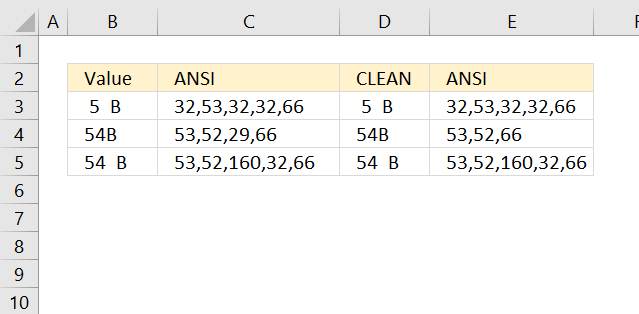
How to comment
How to add a formula to your comment
<code>Insert your formula here.</code>
Convert less than and larger than signs
Use html character entities instead of less than and larger than signs.
< becomes < and > becomes >
How to add VBA code to your comment
[vb 1="vbnet" language=","]
Put your VBA code here.
[/vb]
How to add a picture to your comment:
Upload picture to postimage.org or imgur
Paste image link to your comment.
Contact Oscar
You can contact me through this contact form